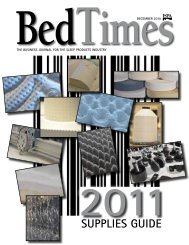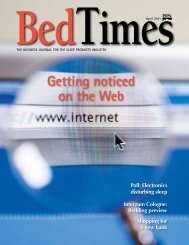Create successful ePaper yourself
Turn your PDF publications into a flip-book with our unique Google optimized e-Paper software.
FactoryDirect<br />
In tough times, target your message<br />
Tips for improving<br />
direct marketing<br />
By Barbara T. Nelles<br />
Economic conditions are taking<br />
their toll on consumers’ responses<br />
to all forms of advertising, including<br />
direct marketing efforts. Still<br />
there is no better time to roll out new<br />
direct mail and other direct-response<br />
campaigns, marketing experts say. In<br />
fact, engaging in direct marketing may<br />
be critical if you want to continue to<br />
reach consumers during tough times.<br />
Direct marketing allows companies<br />
to target previous customers—a very<br />
important group in times like these,<br />
when prospecting for new customers<br />
is especially difficult. Your previous<br />
customers know you and your<br />
business and they are more likely to<br />
respond to your value-driven offer.<br />
Direct marketing is any type of<br />
targeted communication that seeks<br />
a direct response from consumers,<br />
the results of which are collected in a<br />
database for future analysis and use.<br />
It can involve many different types of<br />
delivery, including postal, broadcast,<br />
phone, point-of-service and digital.<br />
Direct mail is the most familiar. Digital<br />
is the fastest growing.<br />
Whatever medium you choose,<br />
there are several things to consider<br />
when drafting your message,<br />
according to Tony Attwood, direct<br />
mail guru and founder of<br />
Hamilton House Mailings plc in<br />
Corby, England, and Lois Boyle-<br />
Brayfield, president of direct marketing<br />
agency J. Schmid & Associates<br />
Inc. in Kansas City, Mo.<br />
1Place your name, location and contact<br />
information in plain sight—it’s<br />
the first thing a recipient looks for.<br />
www.sleepproducts.org/bedtimes<br />
2Headline a benefit such as “No<br />
more backaches when you sleep<br />
on a ______”—not lists of product<br />
features.<br />
3Do support that headline benefit<br />
with a strong value story—<br />
especially in today’s economy. Provide<br />
facts and figures that underline value,<br />
add a free gift or extra discount to<br />
compel consumers to act.<br />
4Remember “you” and “free” are<br />
the two most powerful words you<br />
can use.<br />
5Put your most powerful words at<br />
the beginnings of sentences and<br />
paragraphs.<br />
6Include a call to action. Tell the<br />
reader what you want her to do<br />
and how to do it—and repeat it more<br />
than once in your copy.<br />
Announcements don’t make at-<br />
7 tention-grabbing headlines. “ABC<br />
introduces the XYZ mattress” will not<br />
work—nor will following it up with<br />
your number of years in business and<br />
the latest technology behind the XYZ.<br />
8If you’ve included a special offer,<br />
articulate it in a clear, compelling<br />
manner. Try testing different<br />
offers with different list segments.<br />
Which offers worked in the past?<br />
Can you brainstorm a giveaway that<br />
will not impact your margins?<br />
9Beware of focusing the entire<br />
message on having the lowest<br />
price—it will only work if you really<br />
are less expensive than everyone<br />
else, which is a difficult promise to<br />
make in a highly competitive category<br />
and economy. And it can have<br />
unintended results, like starting a<br />
price war in your market.<br />
Consider posing a provoca-<br />
10tive question in the headline:<br />
“Are these the 3 things you dread<br />
most about mattress shopping?”<br />
Recipients will read on just to see if<br />
you got it right. Develop your question<br />
and provide your solution in a<br />
paragraph or two, using a conversational—not<br />
promotional—style.<br />
Make information easy to<br />
11understand and don’t assume<br />
anything. Write in short paragraphs<br />
and avoid fine print and disclaimers<br />
<strong>BedTimes</strong> | May 2009 | 81
















